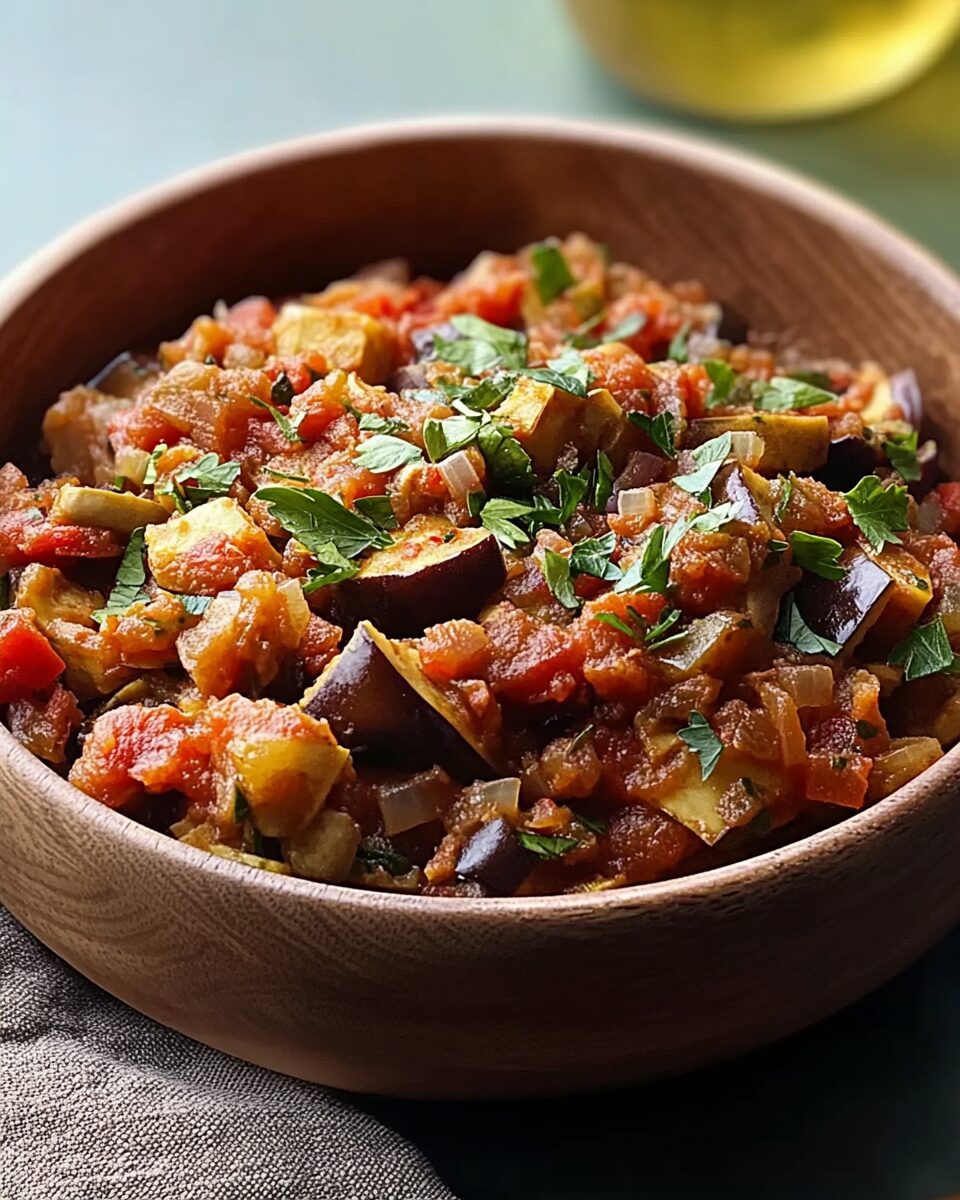Eggplant Caponata is a traditional Sicilian dish that brings together the rich, earthy flavors of eggplant with the sweet and sour notes of vinegar and sugar. This dish is a perfect example of the Mediterranean’s balance of flavors, offering a delightful combination of savory and tangy elements with every bite. Whether served as a standalone appetizer or as part of an antipasto platter, Eggplant Caponata is sure to be a crowd-pleaser.
What makes this recipe truly special is its versatility. It can be enjoyed warm or at room temperature, and it pairs wonderfully with crusty bread or as a topping for grilled meats. Caponata is also a great make-ahead dish, as the flavors only improve as it sits, making it ideal for meal prepping or entertaining guests. Whether you’re vegan, vegetarian, or simply looking to try something new, this classic Italian recipe is a must-try.
Full Recipe:
- 2 medium eggplants, diced
- 1/4 cup olive oil
- 1 large onion, chopped
- 3 celery stalks, chopped
- 1 red bell pepper, chopped
- 3 cloves garlic, minced
- 1/4 cup capers, drained
- 1/4 cup green olives, pitted and sliced
- 1/4 cup red wine vinegar
- 2 tablespoons sugar
- 1 (14.5 ounce) can diced tomatoes, with juice
- 1/4 cup fresh basil leaves, chopped
- Salt and pepper to taste
Directions:
- Heat olive oil in a large skillet over medium heat. Add the diced eggplant and cook, stirring occasionally, until golden brown, about 10 minutes. Remove the eggplant from the pan and set aside.
- In the same skillet, add the onion, celery, and red bell pepper. Sauté until the vegetables are softened, about 5 minutes. Add the minced garlic and cook for another minute.
- Stir in the capers, olives, red wine vinegar, and sugar. Cook for 2-3 minutes, until the mixture is well combined.
- Add the diced tomatoes with their juice and bring to a simmer. Cook for 10-15 minutes, until the sauce has thickened slightly.
- Return the eggplant to the skillet and stir to combine. Simmer for an additional 10 minutes, allowing the flavors to meld together.
- Stir in fresh basil and season with salt and pepper to taste. Remove from heat and let the caponata cool to room temperature before serving.
Prep Time: 15 minutes | Cooking Time: 35 minutes | Total Time: 50 minutes
Kcal: 180 kcal | Servings: 6 servings
Eggplant Caponata: A Timeless Sicilian Classic
Eggplant Caponata, or caponata di melanzane, is one of Sicily’s most cherished culinary treasures. With its roots deeply embedded in Sicilian culture, this dish perfectly captures the region’s history of blending flavors, spices, and traditions from various cultural influences. Sicily, being a crossroads of Mediterranean civilizations, has seen Greek, Arab, Norman, and Spanish rule over the centuries, each leaving a distinct mark on its cuisine. Caponata is a prime example of how these influences combine to create a harmonious, flavorful dish.
What Makes Eggplant Caponata Special?
Caponata is a hearty vegetable stew that brings together the rich, meaty texture of eggplant with a balance of sweet and sour flavors. The dish is characterized by the use of ingredients like capers, olives, vinegar, and sugar, which give it its signature agrodolce (sweet and sour) flavor profile. It’s not just the ingredients but the method of cooking that elevates this humble vegetable dish into something complex and multi-layered.
- Sweet and Sour Balance: The defining characteristic of eggplant caponata is its perfect balance between sweet and sour. This combination of vinegar and sugar is a hallmark of Sicilian cuisine, and it transforms simple vegetables into a dish full of depth and flavor.
- Versatile Use: Caponata is incredibly versatile. It can be served as a side dish, appetizer, or even a main course. It’s often used as an antipasto (starter) in Italy, served at room temperature with crusty bread. You can also use it as a topping for grilled fish, a filling for sandwiches, or even as a pasta sauce.
- Regional Variations: In Sicily, nearly every household and restaurant has its own version of caponata. While eggplant is always the star, the supporting ingredients can vary. Some versions include pine nuts, raisins, or even potatoes. Depending on the region, you might also find variants with anchovies or seafood.
- Healthy and Nutritious: Eggplant Caponata is not just delicious; it’s also a healthy choice. Eggplant is a low-calorie vegetable that’s rich in fiber, vitamins, and minerals. The other ingredients, like olives and capers, add heart-healthy fats, and the tomatoes are a great source of antioxidants.
Historical Context and Influence
Sicily has always been a melting pot of cultures, thanks to its strategic location in the Mediterranean. The island has been influenced by the Greeks, Arabs, Romans, Normans, and Spanish over centuries, and each of these civilizations has left its mark on Sicilian food.
- Greek Influence: The Greeks introduced the concept of combining vegetables with olive oil, which became foundational in Sicilian cooking. Caponata showcases this method by frying eggplant until golden and then mixing it with an olive oil-based sauce.
- Arab Influence: The Arabs brought sugarcane to Sicily, and their love for sweet and savory combinations is clearly evident in dishes like Caponata. The agrodolce flavor profile (a balance of sweet and sour) is a key characteristic of Sicilian cuisine and can be traced back to this influence.
- Spanish Influence: During Spanish rule, the tomato was introduced to Sicily, which has since become an essential ingredient in many Sicilian dishes. The tomato’s natural sweetness and acidity complement the vinegar and sugar in Caponata perfectly.
How to Serve Eggplant Caponata
One of the reasons for Caponata’s widespread appeal is its versatility. It can be served in various ways, depending on the occasion or your culinary preferences:
- As an Appetizer: Traditionally, caponata is served as an antipasto. It’s often eaten at room temperature with a slice of crusty bread. The dish’s vibrant flavors make it the perfect way to start a meal.
- As a Side Dish: Caponata pairs wonderfully with grilled meats, fish, or poultry. Its tangy and sweet notes cut through the richness of the meat, making it a perfect complement.
- As a Main Course: For a light yet satisfying meal, caponata can be served on its own as a main dish. You can add it to pasta, top it on couscous, or stuff it into baked vegetables like bell peppers or zucchini.
- As a Topping: Many enjoy spreading Caponata on sandwiches or using it as a pizza topping. It can even be used as a garnish for bruschetta, adding complexity to a simple bite.
Cooking Tips and Tricks
While making caponata is relatively straightforward, there are a few tips and tricks to ensure that you achieve the best results:
- Salting the Eggplant: Some cooks recommend salting the eggplant before cooking to draw out excess moisture and bitterness. After letting the diced eggplant sit with salt for about 30 minutes, you can rinse it and pat it dry before cooking. This step results in a firmer texture and enhances the eggplant’s natural flavor.
- Cooking in Batches: Eggplant absorbs oil very quickly, so it’s important to cook it in batches. This ensures that the eggplant browns evenly and doesn’t become soggy.
- Flavor Development: Like many stews, caponata tastes even better the next day. The flavors deepen as the ingredients have time to meld together, so if you’re planning to serve it for a special occasion, make it ahead of time.
- Customization: Feel free to add or subtract ingredients according to your taste. Pine nuts and raisins are common additions, offering a little extra sweetness and texture. You can also add herbs like thyme or oregano for an added layer of flavor.
Why You Should Try Making Caponata
Caponata is a must-try for anyone who loves Mediterranean flavors or is looking to explore Sicilian cuisine. It offers a unique combination of textures and flavors that is rarely found in other vegetable dishes. Whether you’re a fan of eggplant or someone looking to add more plant-based meals to your diet, this dish delivers on both taste and nutrition.
- Cultural Experience: By making caponata, you’re not just cooking a meal; you’re experiencing a piece of Sicilian history. This dish has been passed down through generations, and by preparing it, you’re connecting with a centuries-old culinary tradition.
- Perfect for Entertaining: If you’re hosting a gathering, caponata is an excellent choice for your menu. It’s an impressive dish that looks beautiful on the table and can be served at room temperature, making it easy to prepare ahead of time.
- Dietary Flexibility: Caponata is naturally vegan, gluten-free, and can be made low-carb by omitting certain ingredients. This makes it suitable for a wide range of dietary preferences, ensuring that everyone at the table can enjoy it.
Conclusion
Eggplant Caponata is a dish that captures the essence of Sicilian cuisine: vibrant, flavorful, and steeped in history. Its agrodolce balance of sweet and sour makes it stand out from other vegetable stews, offering a unique eating experience that is both comforting and exotic. Whether you serve it as a side dish, appetizer, or main course, caponata is a versatile dish that brings the flavors of the Mediterranean to your table.
For those interested in exploring Italian or Mediterranean cuisine, Caponata is a fantastic starting point. Its combination of simple ingredients and complex flavors provides a rewarding cooking experience. Whether you’re preparing it for a weeknight dinner or a special gathering, this dish is sure to impress and satisfy.






